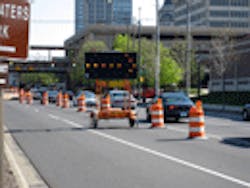Bipartisan highway bill heads to full Senate
The U.S. Senate Environment and Public Works Committee (EPW) yesterday reported out S.1813 “Moving Ahead for Progress in the 21st Century” (MAP-21), a bill to reauthorize the nation’s transportation programs for two years. According to the committee, its unanimous approval of the bill “illustrates broad bipartisan support for passage by the full Senate.”
S. 1813 is now headed to the full Senate for consideration, where it will be combined with measures from the Senate Committee on Finance, Committee on Commerce, Science and Transportation, and Committee on Banking, Housing and Urban Affairs.
On the House side, the highway reauthorization proposal is currently in the hands of the Transportation and Infrastructure Committee.
According to an EPW news release, the bill “maintains funding at current levels, reforms the nation’s transportation programs to make them more efficient, and provides robust assistance for transportation projects under the Transportation Infrastructure Finance and Innovation Act (TIFIA) program to leverage state, local, and private-sector funding.”
The current surface transportation bill expires on March 31. Many groups, the committee noted, ranging from the U.S. Chamber of Commerce to the AFL-CIO, have called for immediate action to reauthorize transportation programs.
S.1813 is a bipartisan piece of legislation - cosponsored by Sen. Barbara Boxer (D-CA), chairman of the Environment and Public Works Committee; Sen. James Inhofe (R-OK), ranking member of the committee; Sen. Max Baucus (D-MT), chairman of the Transportation and Infrastructure Subcommittee; and Sen. David Vitter (R-LA), ranking member of the subcommittee.
“By moving forward with a unanimous vote on MAP-21, this committee sends a strong signal that we are serious about job creation and getting our economy back on track,” said Boxer. “This cooperation is a rare win for bipartisanship, and I believe it will provide encouragement to the finance committee as they work to ensure full funding for this two-year effort.”
“Today’s unanimous vote in committee in support of our highway bill shows that momentum is on our side in the Senate to pass this important jobs legislation,” said Inhofe. “I am pleased to have worked with Sens. Boxer, Vitter and Baucus and commend them for their efforts. The next step is to address the $12 billion shortfall in funding. With the dedication of Sens. Baucus and Crapo, and the rest of the finance committee, I am confident we will find the needed funds. Doing so is essential to jump-start the economy for Oklahoma and the nation.”
Baucus pointed out that since Montana is a “highway state…we know firsthand that investing in transportation infrastructure creates good-paying jobs in the short term and for the long haul. Highways are our lifeblood in Montana and this bill is a good place for us to find common ground for our nation.”
“Our bipartisan highway bill is a jobs bill, an infrastructure bill which is designed to succeed and can succeed,” said Vitter. “Our reform approach, which has zero earmarks, will allow the state and MPOs greater flexibility to work together with the private sector to meet their local transportation needs - with much less federal bureaucracy slowing down the process.”
Speaking to the reform aspect of the bill as well, Boxer noted that the legislation consolidates 90 programs into 30. “While it continues the current level of funding plus inflation which protects 1.8 million jobs, according to the Transportation Department, it also will create up to one million more jobs through leveraging in the Transportation Infrastructure Finance and Innovation Act (TIFIA) program,” she added.
American Trucking Assns. president & CEO Gov. Bill Graves applauded the consolidation effort that went into the bill as well. “By consolidating the myriad of federal programs into just a handful of major initiatives, including one dedicated solely to the movement of freight, this [committee] draft ensures that federal dollars will be spent more wisely,” he stated.
Graves also noted that in addition to there being a freight-specific program, “ATA is pleased that the committee’s proposal includes a provision to provide more truck parking through the enactment of Jason’s Law. We are also especially appreciative, in a time of fiscal restraint, that the committee has shown the wisdom to steer clear of the siren song of tolling to finance these needed changes. By preserving the current restrictions on tolling our Interstate system, the committee is ensuring that users of our highways continue to be taxed fairly and efficiently for that use.”
However, Graves noted that as with any large piece of legislation, “there are a number of parts of the bill that concern ATA… we hope they can be addressed as the process moves forward.”
NATSO, the national association representing truckstops and travel plazas, applauded the committee for unanimously putting forth a bipartisan highway reauthorization bill. “We applaud Senate EPW Committee chairwoman Barbara Boxer, ranking member James Inhofe, and the entire committee for approving MAP21, which would create hundreds of thousands of jobs, make our roads safer, and reduce the time professional drivers and other motorists waste in highway gridlock,” said NATSO president & CEO Lisa Mullings. “We urge full Senate passage of this important legislation.”
Mullings also was pleased that a “Jason’s Law” provision was included to provide more funding for truck parking. She said this measure would authorize states to use certain appropriated dollars for truck parking facilities. According to Mullings, this would include the construction of rest areas with expanded truck parking; construction of commercial truck parking facilities adjacent to commercial truck stops and travel plazas; the opening of existing inspection and weigh station facilities to truck parking; and promoting the availability of publicly or privately provided truck parking on the National Highway System using intelligent transportation systems.
